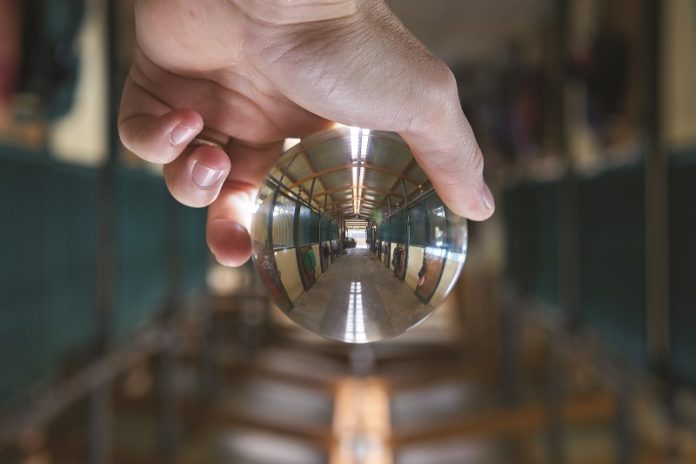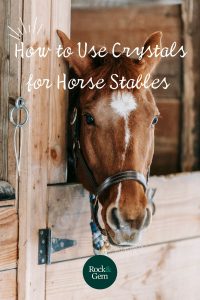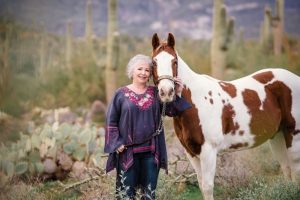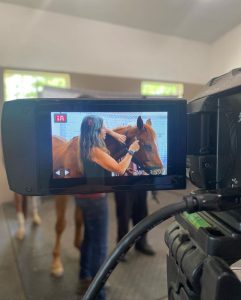
How to use crystals in horse stables is becoming more popular as horse owners take a fresh embrace of holistic and spiritual energy. You won’t have to look far to find horsepeople choosing crystals to create stable environments.
“The Sultan made his way to the six Arabians and tied a silken bag around the neck of each.

There was a dark red bag for the chestnut, a pale yellow one for the dun, a gray bag for the dappled grey, a white bag for the white, a black one for the black, and for Sham there was a bag made of shiny gold cloth.
The Sultan’s shrill voice pierced the quiet. “These bags contain amulets of great power, that will prevent and cure the bite of scorpions and protect your stallions from evil spirits. Guard these well.” – ‘King of the Wind: The Story of the Godolphin Arabian,’ by Marguerite Henry, 1948.
It has been 74 years since the author of some of the most beloved books in children’s literature added a mention of amulets to her Newberry Medal-winning story of stallions bound from Morocco for a French king’s court. (How to use crystals – amulets defend and protect against; talismans are used to attract.)
Historically, Henry was right on track. The world’s oldest stables, discovered in 1999, were built for Ramses II (1304- 1237 B.C.) in the Egyptian city of Qantir-Piramesse and stabled 480 horses for breeding, war and pleasure, and a stable in the Nabatean/Byzantine city of Mampsis dating to 100 A.D. (and in use until the 7th century) hosted a thriving Arabian horse breeding operation.

Image courtesy Jennifer Alyse
Stable Stones
Photographer Paula da Silva has traveled the world – from Iceland to Morocco – portraying horses. Knowing how to use crystals, back home in Italy, she has used them for more than a decade to create a tranquil equine environment.
When a broodmare was ready to give birth, Paula placed amazonite stones in each corner of the foaling stall. Amazonite, also called the “hope” stone, is a variety of potassium feldspar in the mineral class, Microline.
“It is a green stone that I bought in Brazil to heal fears, loneliness, calcium deficiency, panic and communication problems. It’s a nice stone when you hold it in your hand, and it really worked. We had two foaling stalls. Only one had the stones. Mares in that stall were calmer and delivered their foals with no fear,” Paula said.
She used quartz with hematite inclusions for mares prone to ‘silent’ heats (no outward signs of estrus). “I would put two stones on the halter or in a small pocket attached to the blanket to help a mare relax and accept a stallion (for breeding), and encourage a sense of peace and serenity.”
She uses transparent quartz, which offers energy and a clear mind, with horses before a long transport. Like Henry’s fictional Sultan, the crystals go in a tiny mesh bag Paula can then braid into the mane or attach to the blanket. Crystals can be worn on a horse as well as placed in (or even underneath) a barn.
“I have a friend who uses amethyst for its calming effects on both her horse’s halter and on its stall door,” says Deena Bak, Hatha Yoga instructor, owner of the crystal-infused home line, Starchild Creative, and program director at Diamond Mountain Mining, Ltd. in Little Falls, NY.
American Veterinary Chiropractic Association (AVCA)-certified equine chiropractor and educator, Wendy Coren, and her husband and partner in their equine wellness practice, Dr. David Lundquist, had rare earth magnets installed in the corners of the foundation of their Lake Worth, Florida barn.
“Samarium-cobalt (SmCo) and neodymium (NdFeB) are called ‘rare earth’ magnets,” Wendy explained, “because they are made from the lanthanide or ‘rare earth’ series of the periodic table of elements.” Studies support that strong magnets, like Neodymium Magnet therapy, have the potential to reduce swelling, bruising and pain in those recovering from surgery.
Wendy put rose quartz, jade, tiger’s eye and amethyst in the window of each stall, including that of her Morgan, Cisco, as well as in the barn’s conference room. “A contractor thought I was crazy. Then he called me a few months later from a job site in North Carolina, asking what I used because he could feel the difference!”
Paula Brown, owner of Mayfair Morgans in Boothbay, Maine, recalls a late friend and trainer, “Who used crystals all over her barn, plus specific stones for each horse based on their personality.” As for using crystals with her own horse she laughs, “Not Frankenpony! He would either eat them or throw them at the barn help!”
If you can trust your horse not to eat (or fling) them, a good place for crystals is a water bucket. Quartz crystals are a safe energy choice in water but if you are hesitant about leaving loose stones at the bottom of a bucket try this: Put the crystal(s) in a water bottle overnight then pour the infused water into the bucket the next day.
As any horse (or animal) lover knows, some of the most spiritually intimate moments are during grooming or bathing. This is a good chance for how to use crystals to enhance those good vibrations with a few small stones inside your pocket or apron.

Image courtesy Wendy Coren
Chestnuts, Duns & Greys
Crystals or semi-precious stones are a useful and easy tool to promote self-healing in horses and their environment. They can be placed anywhere and on any/all sides of a stable (providing they are safely out of reach of inquiring muzzles). And just as horse breeds present a variety of coat colors and patterns, different stones have their own unique energetic contributions.
Amber comes from the resin of a tree and is considered a warming stone with protective qualities. Its rich golden quality encourages horses to feel safer, more trusting and more confident.
Citrine is particularly useful during the gloomier winter months when its bright yellow color serves best to warm and motivate.
Clear quartz is helpful for eradicating negative excess energy that could lead to a horse spooking and balancing over-active or under-active energy flows.
Green Moss Agate has a calming effect and activates the heart chakra to help horses suffering from depression or struggling with trust issues.
Red Jasper is a strong grounding crystal that helps create calming energy in fearful or spooky horses. Its red color promotes a positive, healing energy flow.
Rose Quartz is a popular choice for nurturing an environment of love, self-esteem and personal expression, and appears to have a soothing effect on animals.
Turquoise is a shaman stone used by Native Americans to protect and adorn their horses before battle and enabling its wearer to more deeply connect to the spirit realms and their own soul.

Image courtesy Wendy Coren
Good Horse Sense
Lynn McKenzie, of Sedona, Arizona, is a globally recognized teacher in the animal intuitive and energy healing fields (lynnmckenzie.com/training), and author of Bark, Neigh, Meow: Awaken to the Transformative Wisdom of Your Companion Animal to Activate Your Soul’s Highest Calling.
If you’ve never used crystals before, she has four suggestions for a good “starter kit” for learning how to use crystals. But before you begin using crystals, it’s important to clear their energy. This can be done, she says, by leaving the crystal out in the sunlight (or moonlight), with smoke from a smudge stick or with your intention.
“Generally, I’ve never found any resistance [to using crystals] from newbies,” she said. “When people are on their healing path they are ready and excited to learn how an ‘inanimate object’ has energetic/healing properties or frequencies.”
Lynn suggests four Master Healer crystals that can be used for any and all conditions: “Amethyst, clear quartz, rose quartz, and smoky quartz. Amethyst soothes fears and stresses. Clear quartz crystals help send and remove energy from an area. Smoky quartz helps calm and release stress. Rose quartz is the crystal of joy and unconditional love, good with animals that are abused, abandoned, or neglected, and one of my favorite go-to crystals.”
Lynn has two caveats for how to use crystals: Always make sure the crystals you are using are large enough not to be ingested by any animal in your household and crystal healing is not meant to replace veterinary care.
“Crystals impact all living beings equally. As a rule,” she concluded, “horses are very receptive to any healing energy. They are usually open and interested, and have no attachment, like humans often do, to their imbalance.”
Knowing how to use crystals in horse stables — like riding — may be a method to bring horses and humans into balance together.
This story about how to use crystals in horse stables appeared in Rock & Gem magazine. Click here to subscribe. Story by L.A. Sokolowski.














